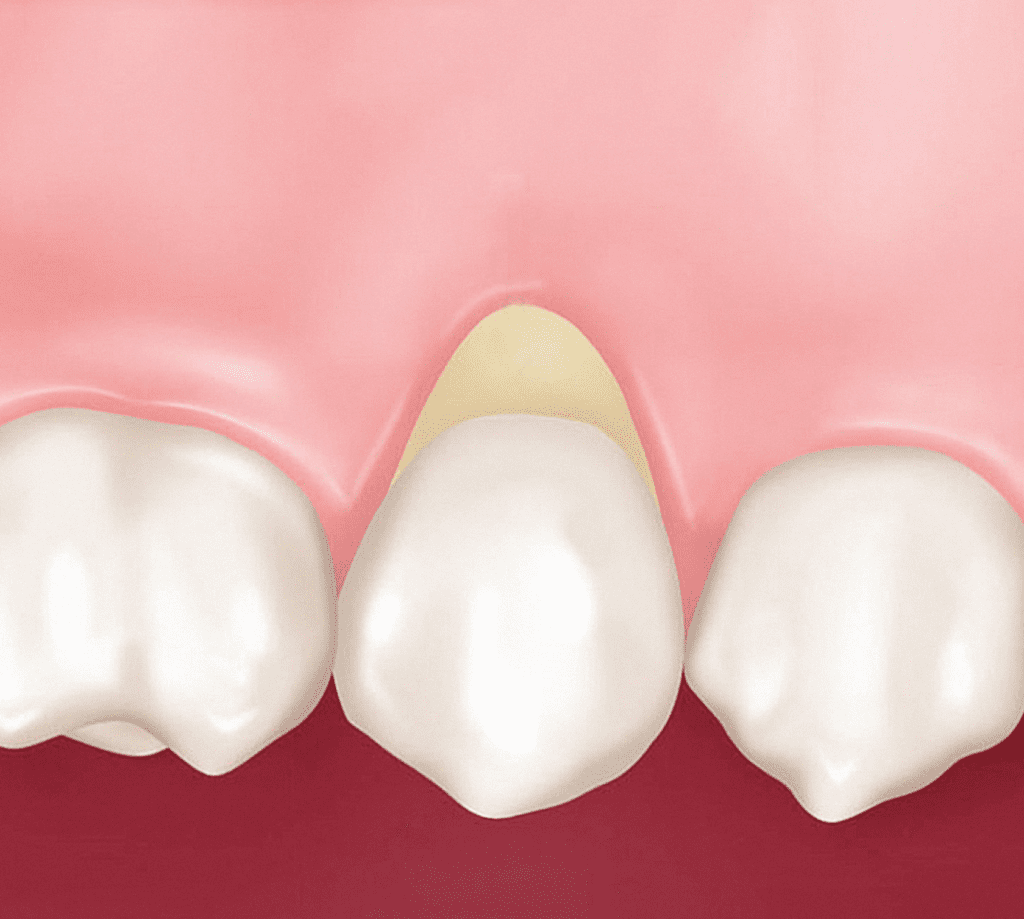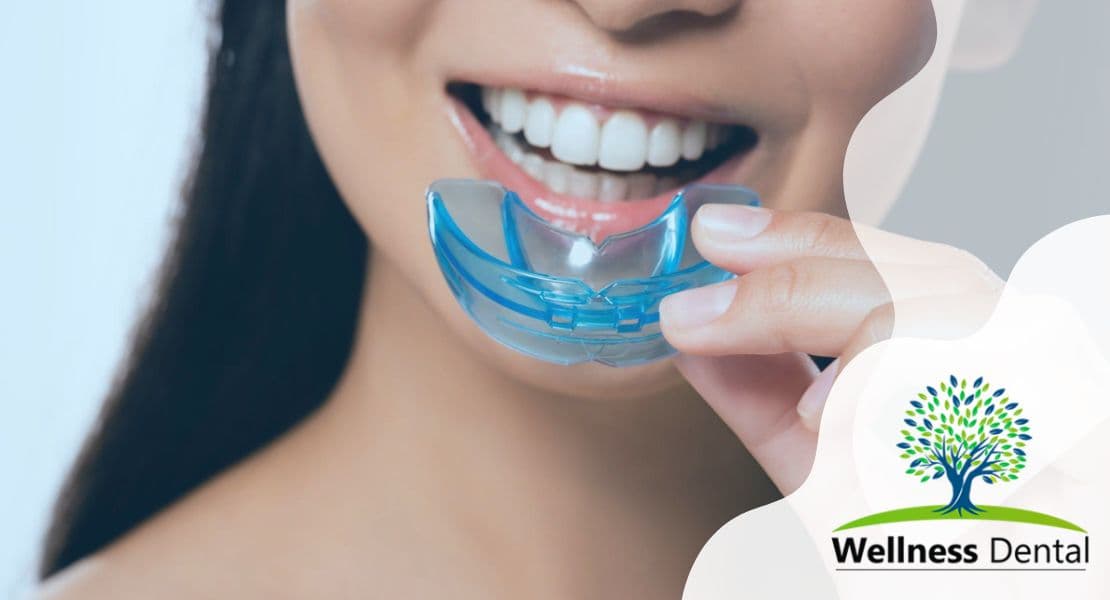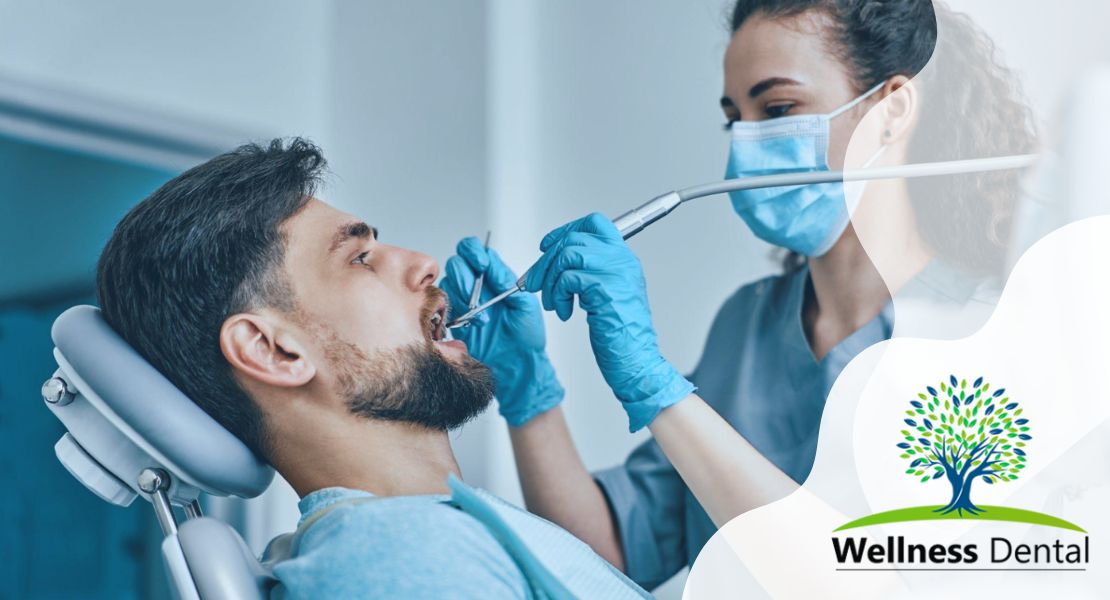There are several common causes of exposed tooth roots. Receding gums, often caused by gum disease, can lead to the root of the tooth becoming exposed. Aggressive brushing and poor dental habits can also contribute to gum recession. Additionally, genetic predisposition and the natural aging process can increase the likelihood of experiencing exposed tooth roots.
Bacteria play a significant role in causing decay, which can eventually break through the surface of the tooth and expose the root. This can lead to increased sensitivity, pain, and an increased risk of infection.
It’s important to address these factors to prevent tooth root exposure in the future. Practicing good oral hygiene, using a soft-bristled toothbrush, and seeking professional dental care regularly can help prevent gum recession and decay. Understanding the potential causes of exposed tooth roots and taking proactive steps to address them can help maintain oral health and prevent the discomfort and complications associated with tooth root exposure.
What is happening with exposed teeth roots?

Teeth roots can become exposed due to various reasons, including gum recession and decay. Gum recession occurs when the gum tissue wears away, exposing the roots of the teeth, while decay can erode the enamel and cause the roots to become visible. Exposed roots can lead to sensitive teeth, increased risk of decay, and even tooth loss if left untreated.
Signs of exposed roots include tooth sensitivity to hot and cold temperatures, discomfort while chewing, and visibly receding gums. It is important to seek dental care if these signs are present, as early intervention can help prevent further damage and address the underlying causes.
Dental care for exposed roots may include treatments such as desensitizing agents, fillings, or gum grafting to cover the exposed roots and protect them from further damage. Maintaining good oral hygiene, including regular dental check-ups and cleanings, can also help prevent and detect early signs of gum recession and decay.
Identifying Exposed Roots
Signs and symptoms of an exposed tooth root include tender gums, bleeding while brushing or flossing, and the appearance of longer teeth. In some cases, the tooth may also become sensitive to hot, cold, sweet, or acidic foods and drinks.
To check for exposed tooth roots, stand in front of a mirror and open your mouth as wide as possible to see beyond the gum line. Look for areas where the gum has receded and the root of the tooth is now visible.
Several factors can cause a tooth root to become exposed, such as gum recession, which can be caused by periodontal disease or aggressive brushing. Tooth decay, poor alignment of teeth, and teeth grinding can also contribute to the exposure of the tooth root.
If you notice any signs or symptoms of an exposed tooth root or are concerned about the health of your gums and teeth, it is essential to consult a dentist for proper evaluation and treatment. Early recognition and intervention can help prevent further damage to the tooth and surrounding tissues.
Watch out for these causes and how to avoid them
When it comes to staying healthy and avoiding potential health hazards, it’s important to be mindful of common causes that can lead to illness or injury. By being aware of these potential dangers and taking steps to avoid them, you can better protect yourself and your loved ones from harm. In this article, we will explore some common causes of health issues and how you can prevent them from affecting you. From foodborne illnesses to preventing accidents at home, being on the lookout for these causes can help you stay healthy and safe.
Injuries to the gum
Injuries to the gum, whether from a tooth injury or damage to the gum tissue, should be addressed promptly with dental care. Seeking prompt dental care is crucial for assessing and treating the injury to ensure proper healing and prevent further damage.
It is important to understand the significance of addressing injuries to the gum promptly, as untreated injuries can lead to gum recession, which can result in loss of tooth support and potential tooth loss. To prevent gum recession, avoid behaviors that increase the risk, such as smoking and brushing too hard. Additionally, maintaining good oral hygiene practices, such as regular dental check-ups and cleanings, can help prevent gum recession.
In conclusion, seeking prompt dental care for injuries to the gum is essential for proper treatment and to prevent potential gum recession. By avoiding risk-increasing behaviors and maintaining good oral hygiene practices, you can help prevent gum recession and maintain the health of your gums.
Gum Disease
Gum disease prevention is crucial for maintaining overall oral health. Regular oral health care routines, including brushing, flossing, and dental checkups, play a significant role in preventing gum disease. Neglecting these routines can lead to conditions such as gingivitis and periodontitis. Risk factors for gum recession, such as smoking, diabetes, and poor oral hygiene, can also contribute to the development of gum disease.
Gingivitis is the early stage of gum disease which, if left untreated, can progress to periodontitis. This advanced form of gum disease can lead to gum recession, damage to the bone structure supporting the teeth, and eventual tooth loss. Neglecting oral health care also increases the risk of developing other health issues, including heart disease and diabetes.
It is essential to emphasize the need for good brushing techniques, dental flossing, and regular dental visits to maintain healthy gums and prevent gum disease. Regular checkups with a dental professional can help detect early signs of gum disease and provide necessary treatment. By prioritizing oral health care, individuals can protect their gums and overall well-being from the potential consequences of neglecting oral health.
Infections
To identify the symptoms of a tooth root infection, one should look for signs such as receding gum tissue and exposed tooth roots. Receding gum tissue can be characterized by gums that appear to be pulling away from the teeth, making them look longer than usual. Exposed tooth roots may be visible when the gums have receded, and can often appear discolored or darker than the rest of the tooth.
Leaving a tooth root infection untreated can lead to various severe health issues. The infection can spread to the surrounding tissues and bones, causing further damage and potentially leading to tooth loss. In more severe cases, the infection can enter the bloodstream and spread to other parts of the body, putting the individual at risk of developing systemic health issues such as heart disease and diabetes. Additionally, the presence of untreated infections can weaken the immune system and make the body more susceptible to other infections and illnesses.
It is important to seek proper dental care if any symptoms of a tooth root infection are present to prevent the infection from progressing and causing more severe health complications.
Breakage
If you experience a breakage of a tooth that results in the exposure of the root, it is important to seek immediate dental care to prevent further damage and potential infection. Contact a dental professional as soon as possible to discuss the situation and schedule an emergency appointment.
In the meantime, you can rinse your mouth with warm water and apply a cold compress to help reduce any swelling or discomfort. Avoid touching the exposed root and try to keep the area clean to minimize the risk of infection.
Upon visiting the dentist, they will assess the extent of the damage and discuss potential treatment options with you. This may include procedures such as a root canal, dental crown, or other restorative treatments to protect the exposed root and restore the tooth’s appearance and function.
It is crucial to address tooth breakage and exposed roots promptly to prevent further complications and ensure the best possible outcome for your oral health. Follow any post-treatment instructions provided by your dentist to support healing and long-term dental health.
Misalignment
If you are experiencing misalignment issues with your teeth, it is crucial to address them early to prevent potential problems such as gum tissue recession and exposure of the tooth root. To begin addressing misalignment, it is important to schedule an appointment with an orthodontist for a thorough evaluation and to discuss potential treatment options.
During the evaluation, the orthodontist will assess the extent of the misalignment and recommend a suitable treatment plan. This may include options such as braces, aligners, or other orthodontic devices to gradually move the teeth into their proper positions.
By addressing misalignment early through an orthodontist appointment, you can prevent further complications and achieve a healthier, more aligned smile. Remember that misalignment can lead to gum tissue recession and exposure of the tooth root, so seeking professional help is crucial for maintaining your oral health. Don’t hesitate to schedule an appointment with an orthodontist to address misalignment and explore your treatment options.
Other issues
Other issues that may cause gum recession and expose the tooth root are cysts, medication side effects, and complications of oral surgery. These issues can contribute to the deterioration of the gum tissue, leading to an exposed tooth root. Cysts, which are fluid-filled sacs, can develop in the gum tissue and cause damage to the surrounding areas, including the root of the tooth. Certain medications, such as antihypertensive drugs and immunosuppressants, can have side effects that affect the gums and lead to recession. Complications from oral surgery, such as excessive trauma or infection, can also result in gum recession and expose the tooth root.
Symptoms of an exposed tooth root may include visible projections of the root surface, tooth sensitivity, and potential discoloration of the affected tooth. Potential factors that may lead to an exposed tooth root include poor oral hygiene, aggressive brushing, tooth damage or trauma, genetic anomalies, and periodontal disease.
It is important to address these issues with the help of a dental professional to prevent further damage and to explore treatment options such as gum grafting, root coverage procedures, and addressing the underlying cause of the gum recession.
Possible Solutions for Addressing Exposed Tooth Roots
Dealing with an exposed tooth root can be both painful and aesthetically unpleasant. However, there are several options available for fixing this issue. From simple at-home remedies to professional dental interventions, there are various ways to address the problem and alleviate any discomfort you may be experiencing. In this article, we will explore some of the different options for fixing your exposed tooth root and discuss the potential benefits and drawbacks of each approach.
Whether you are looking for temporary relief or a more permanent solution, there are several avenues to explore when it comes to addressing this common dental issue. By understanding your options, you can make an informed decision about the best course of action for your unique situation.
Root canal therapy
Root canal therapy is a dental treatment used to treat infections in the tooth and tooth root. The process involves removing the infected or inflamed pulp from the inside of the tooth and cleaning, disinfecting, and sealing the tooth to prevent further infection.
The root canal system consists of the pulp chamber located in the center of the tooth and extends down the length of the root. The entrances to the root canals are found in the pulp chamber and the canals taper towards the apex of the tooth.
During treatment, the dentist carefully removes the infected core of the tooth, including the pulp and any bacteria present, and then cleans and shapes the root canals before sealing them with a filling material. In some cases, a dental crown may be placed over the treated tooth to provide additional protection and support.
In clinical situations where there is a delta of small canals in the root canal system, it is essential for the dentist to thoroughly clean and shape these intricate structures to ensure the success of the treatment.
Root canal therapy is an effective way to save a tooth that would otherwise require extraction due to infection, and it can alleviate the pain and discomfort associated with tooth infections.
Removal of the tooth
To remove a tooth, the first step is to determine if a surgical removal or dental extraction is needed. If the tooth is decayed and cannot be saved, extraction may be necessary. During a dental extraction, the dentist will first administer a local anesthetic to numb the area around the tooth. Then, they will use specialized tools to gently loosen the tooth from the socket before carefully removing it. If the tooth requires surgical removal, such as impacted wisdom teeth, the dentist will make a small incision in the gum and may need to break the tooth into smaller pieces for easier removal.
Potential reasons for tooth removal include severe decay, infection, crowding, or damage from trauma. After the procedure, the dentist will provide instructions for post-operative care, which may include managing any discomfort and swelling. In some cases, pain medication or antibiotics may be prescribed. It is important to follow the dentist’s recommendations for a smooth recovery. Whether it’s dental extraction or surgical removal, the dentist will ensure that the procedure is as comfortable as possible, and the patient will be given proper care to promote healing.
Implant
A dental implant is a procedure where a small screw is placed into the jawbone to serve as an anchor for a false tooth. The process involves surgically inserting the screw into the jawbone, allowing it to fuse with the bone over time. Once the implant has fully integrated with the jawbone, a false tooth can then be attached to the screw, effectively replacing the missing tooth.
Factors that may lead to the need for an implant include a tooth with an exposed or damaged root that cannot be treated through other dental procedures. In such cases, an implant may be the best solution to restore functionality and aesthetic appearance.
Seeking professional dental treatment for implant procedures is essential to ensure the success and safety of the implant. Qualified dental professionals have the knowledge and expertise to carefully assess the patient’s oral health, perform the implant procedure with precision, and provide post-operative care to promote proper healing and integration of the implant with the jawbone.
When Roots Are Exposed Too Far For An Easy Fix
When tooth roots are exposed too far for an easy fix, there are several potential treatment options that may be considered.
Root canal treatment is a common option for addressing exposed tooth roots. This involves removing the infected or damaged tissue from inside the tooth and sealing it to prevent further damage. Another option is gum flap surgery, where the gum tissue is folded back to allow for deep cleaning and repositioning of the gums to cover the exposed roots. Dental implants are also a possible solution for severely damaged or exposed tooth roots, providing a more permanent replacement for the natural tooth.
However, treating overexposed tooth roots comes with potential challenges. There is a risk of infections due to the exposed roots, which may require antibiotic treatment. Additionally, oral surgery may be necessary to address the root cause of the exposure and to prevent further damage.
Common causes of exposed tooth roots include aggressive brushing, gum disease, and periodontal disease. It’s important to address these underlying issues to prevent further damage to the tooth roots.
From Dentist Visit to Daily Care: Maintaining Healthy Teeth Post-Root Exposure
To keep your teeth healthy and prevent exposed tooth roots, it is essential to consistently practice good oral hygiene. This includes brushing your teeth at least twice a day with fluoride toothpaste, and flossing daily to remove plaque and food particles that can lead to gum disease and tooth root exposure. Additionally, wearing a mouthguard during sports or a retainer as directed by your dentist can protect your teeth from injury and maintaining the proper alignment.
Investing in a teeth whitening system can also help maintain the overall health and appearance of your teeth. However, it is important to consult with your dentist before using any over-the-counter whitening products to ensure they are safe and effective for your specific oral health needs.
In addition to these daily habits, scheduling regular dental visits is crucial for maintaining good oral health. Your dentist can provide professional cleanings, check for signs of gum disease and tooth root exposure, and offer personalized advice on how to keep your teeth and gums healthy.
By following these actions, you can help prevent exposed tooth roots and maintain a healthy, beautiful smile for years to come.
FAQ
How many roots are in a tooth?
Most permanent teeth have one root, while some may have two or three. Primary teeth, also known as baby teeth, typically have one root. The number of roots in a tooth will vary depending on the type of tooth. For instance, molars may have up to five roots while incisors typically have one or two.
The shape and size of the roots also vary dependent upon the type of tooth. For example, lateral incisors tend to have slender and tapered roots, while molars generally feature broader and more bulbous roots. Additionally, the position of the root may also vary, such as with teeth that are impacted or misaligned.
Which teeth have 3 roots?
Three-rooted teeth are most common in the molar family. Molars often have three roots, with one root located on either side and a third root in the center. This makes molars especially strong and allows them to withstand tough foods like nuts and hard candy. In addition, having a third root helps provide extra support for the tooth structure, making it less prone to damage or decay. However, not all molars have three roots; some may only have two. The shape and size of these roots can also vary from person to person depending on genetics and environment.
What color are tooth roots?
Tooth roots are usually yellowish or off-white in color. This is due to the enamel that covers the root and its connective tissue. The enamel is a hard, protective layer that helps protect the underlying nerve pulp and other sensitive tissues. The enamel also ensures that cold foods don’t cause pain to the tooth’s nerves, which can occur if it becomes exposed. However, in some cases, tooth roots may have a dark coloring due to staining from sweet foods or drinks. This type of stain is typically removed with professional cleaning or whitening products.






